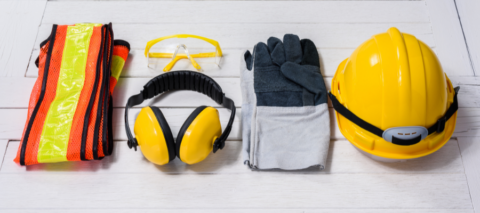We are in the midst of National Burn Awareness Week, seven days dedicated to bring awareness to the hazards of burns, fires, and scalding. The focus of this first week in February is to make known the measures of preventing future burn and scalding incidents. Burns are among the worst injuries the human body can undergo, and there is one place where the risk of getting burned is extremely high— the workplace.
Risks of burns at the workplace can be all around us. Many employees are exposed to sparks, steam pipes, chemicals, electrical currents, and even open flames— and that’s just to name a few. Although rules and safety measures are being set in the workplace, OSHA still cites that in 2011, fire and explosions were the cause of 143 workplace fatalities and 2,200 job site injuries. In honor of National Burn Awareness Week and to help reduce these statistics, let’s take a look at the types of burns that occur in the workplace and how to prevent them.
TYPES OF BURNS:
Thermal Burns
Thermal burns occur from the exposure to flame or heat, and mostly occur on the body’s external surfaces. However, damage to the lungs, nose, and mouth are possible for victims of building fires who have breathed in hot or smoke-filled air.
Thermal burns are usually caused by:
• Scalding liquids (such as boiling water or hot cooking oil)
• Open flames
• Hot objects
• Explosions
• Extended exposure in the sun
Workers whose tasks involves cooking, high temp equipment or material, or flammable chemicals should be particularly cautious in avoiding thermal burns.
Chemical Burns
Chemical burns are usually the result of workplace accidents and occur when the skin or underlying tissue is damaged by caustic chemicals via chemical reaction. Sometimes, these chemicals can be airborne and cause painful internal burns by getting caught in the lungs, nasal cavities, mouth, or other internal areas. Gastrointestinal burns can also occur when chemicals are accidentally swallowed.
Chemical burns are usually caused by:
• Acids
• Strong alkali substances (cement burns)
• Industrial chemicals such as lye and lime
• Household chemicals such as cleaners or fertilizers
• Corrosives
• Oxidizing and reducing agents
• Desiccants
• Vesicants
• Gasoline
Fields with likely exposure to dangerous chemicals include mining, auto repair, medicine, and chemical plant operation.
Electrical Burns
An electrical burn occurs when a person’s body comes in contact with an electrical current. This type of burn causes extensive coagulation necrosis with hyper thermal reaction which causes more subdermal damage than thermal or chemical burns. Sometimes, a person suffering from an electrical burn may have little to no evidence of a serious burn on the surface but may suffer severe internal injury after a direct encounter with electricity.
Electrical burns can usually be caused by:
• Finger in a light socket
• Falling into electrified water
• Touching a live power line
• Getting struck by lightning
HOW TO AVOID BURNS AT WORK:
The best prevention against burns is awareness. Make sure that you and your staff are always aware of the potential dangers of burns on the worksite. This can be done by marking materials and equipment with the proper warning signs and providing signage and handouts that list the procedures that should be taken if a burn does occur.
The other line of defense for burn injuries at work is to wear the proper PPE and clothing. Wearing the right gear can definitely give you the protection you need when it comes to burn safety. Here are a few items you should be wearing when working in close proximity to burn hazards:
General Fire Resistant Clothing
Wool clothing is always suggested because of its durability and resistance to fire. Synthetic clothing should never be worn because it melts when it is exposed to drastic heat. Cotton is okay to wear if it is treated for fire retardation. Also, remember that UV radiation from the sun can also burn the skin. If your job requires you to work in the sun for an extended period of time, make sure you wear sunscreen and clothes that properly cover your body and protect your skin from the sun. Long exposure to UV rays without protection can lead to second and third degree burns.
Safety Glasses
Chemical burns to the eye occur when industrial chemicals or cleaning products splash into the eye. Thermal burns to the eye can also occur, especially among welders, when the eye is exposed to UV radiation (known as “Welder’s Flash”) or when the eye is exposed to flying sparks, molten plastics, metals, or hot gases. That’s why it is important to always wear approved safety glasses with side shields or goggles so your eyes are protected from the risk of burns.
Shoes
The proper footwear can save your feet and ankles from getting burned on the job. Boots made of fire resistant material such as leather are best for protecting your feet against hazards such as flying sparks and hot oil and grease. Metatarsal guards over the shoe laces can protect them from sparks. If you work in a kitchen and around high-temp equipment, it is also best to wear non-skid shoes that can prevent you from slipping and coming in contact with these hot surfaces.
Gloves
To protect against thermal burns, heavy, flame-resistant gloves made from materials such as leather should always be worn. Rubber, non-conductive gloves provide a barrier between your body and electrical currents, and as long as the gloves are dry and in good condition, they will offer some insulation against electric shock. To protect workers against substances that can cause chemical burns, vinyl supported or neoprene supported gloves should always be worn when handling chemicals.
If a burn were to occur on the job, you know that the staff at OHC is always here to help. But we strongly believe that prevention is always better than the cure. In honor of National Burn Awareness week, we encourage you to implement these burn safety tips into your workplace and also to spread the news with others. Let’s make a burn-free workplace together.
MOBILE CLINIC
DIRECT: 251.436.8039
CELL: 251.751.9282
OFFICE: 251.434.6770
EMAIL: ddaniel@occupationalhc.com
PASCAGOULA CLINIC
OFFICE: (228) 762-4642 or (228) 762-4OHC
EMAIL: ddaniel@occupationalhc.com
Resources///////////////////////////////////////////////////////////////////////////////
https://www.skilven.com/national-burn-awareness-week/
http://www.paradigmcorp.com/blog/common-types-of-burn-injuries-and-at-risk-occupations/
http://www.joyelawfirm.com/practice-areas/burn-injury/workplace/
http://safetydailyadvisor.blr.com/2009/02/teach-workers-how-to-treat-workplace-burns/#






